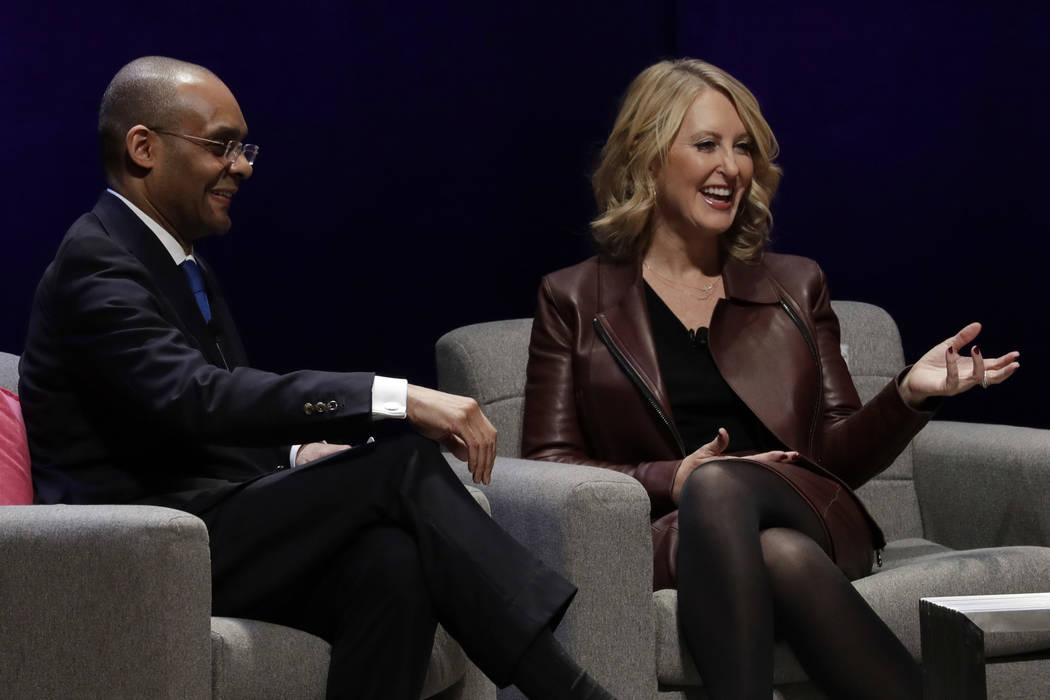Allegiant Stadium at forefront of technological revolution
NFL chief information officer Michelle McKenna and her staff have learned a great deal about integrating technology into the league and its venues during the seven years she has served in the role.
It all will be on display when Allegiant Stadium opens for the 2020 season.
“We’re going to get to see a great example of technology done right when the stadium opens here in Las Vegas,” she said Tuesday at Aria during a 45-minute panel discussion titled “NFL on the Digital Frontier” as part of CES. “Every time a new stadium gets built, you have a chance to up your game, and with the connectivity going online there, we’re looking very forward to the fan experience that’s going to happen in Las Vegas.”
McKenna said she met with builders for a status report Monday during her trip to the league’s newest market and came away impressed with the integration of technology.
“You want to future-proof something when you’re spending billions, but that’s impossible, so you want to build in flexibility,” she said during the discussion as part of the international consumer electronics show. “So we help with that, and we get to learn from every stadium that’s built and every Super Bowl we have. We learn so much and then get to bring it to fruition in every new stadium.”
It’s a far cry from when she joined the league as its first chief information officer in 2012. McKenna said one of her first initiatives was to make sure fans at every NFL stadium could have access to WiFi. Only six had the capability at the time. The rest were done within 18 months.
Now with Allegiant Stadium and SoFi Stadium in Los Angeles opening for the 2020 season, more than half the league’s playing facilities will be 5G-enabled well ahead of most consumers even having access to compatible devices.
McKenna said it’s part of a process that has seen the league’s tech people get involved at the beginning of projects instead of being called in after facilities were already near completion.
“Every company is a tech company now, so you can’t leave your technology part until the end,” she said. “You just can’t. You will fail. We’re in at the very beginning of everything now.”
She hopes it will help enhance the fan experience in an age in which more and more consumers are opting for the comforts of their home on game day.
“We always say the best place to watch an NFL game is an NFL stadium, but let’s face it, the living room is pretty great, too,” McKenna said. “There’s so much you can do with that kind of speed and connectivity. I think 5G will be one of the biggest things because it will allow you to immerse yourself in the games in a different way holding your phone up to the field and getting instant data about who’s on the field or something as simple as the virtual yellow line you see on broadcasts that you don’t see in the stadium.
“I think 5G will really revolutionize the fan experience in everything from ticketing to food and beverage to ingress, egress and the in-seat experience.”
That’s not to say there are no limits to how much the league wants to incorporate the latest trends.
“Technology should never be done for technology’s sake,” McKenna said. “If it doesn’t have a purpose it meets and it’s overkill, then we shouldn’t do it. With that many pieces and parts, that means there’s that many points of failure as well. You can overcomplicate something that in its purest form doesn’t need complicating.”
A prime example would be measuring for first downs. McKenna said the technology is good enough to never have to bring the sticks onto the field again in what is looking more and more like a relic of past generations in an era in which viewers instantaneously know catch probabilities and the top speed each player reached on a particular snap.
“We don’t really need to bring out the chains in the future, but maybe we still will,” she said. “There are things you don’t need to do just because you can. You need to do it because you should and because it will make the experience better, it will make our coaches and players be the best they can be. As long as we keep coming back to those core values, I don’t think we’ll overtech it.”
Still, the advancements keep coming. Sensors in the ball and on uniforms are gathering more and more data with even more planned in stadiums and on the field.
The league has initiatives for gathering information that can help with everything from predicting and reducing injuries to expanding the collection of information and statistics for advanced fantasy games and sports betting opportunities.
“The most important thing we have is the game,” McKenna said. “(We want to ensure) our games are as strong and competitive as always and find new and advanced ways to make sure the game stays as great as it is, but also takes things to the next generation.
“I think five years from now we’ll be talking about how we implemented all those pieces and parts to take the game to an even greater level.”
Contact Adam Hill at ahill@reviewjournal.com. Follow @AdamHillLVRJ on Twitter. A Twitter List by reviewjournal























